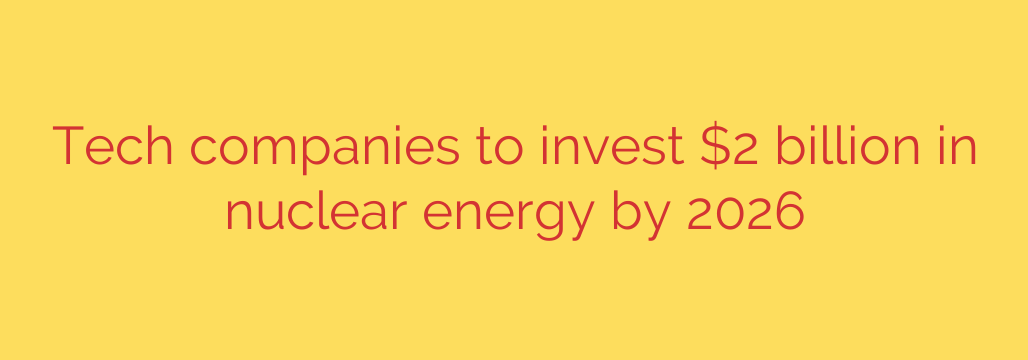
The Power Behind the AI Boom: Why Tech Giants Are Investing Billions in Nuclear Energy
The artificial intelligence revolution is here, powering everything from chatbots to complex scientific research. But this incredible technological leap comes with a hidden and rapidly growing cost: an insatiable demand for electricity. To meet this challenge, the world’s leading technology companies are turning to a powerful and controversial solution: nuclear energy.
In a landmark shift, major technology companies are projected to invest over $2 billion in nuclear energy by 2026 to secure the power needed for their expanding AI operations. This strategic move highlights a critical reality—the digital future we are building requires an energy infrastructure that is not only clean but also incredibly reliable.
The Unprecedented Energy Needs of Data Centers
At the heart of the AI boom are massive data centers, sprawling complexes filled with powerful computer servers. These facilities are the factories of the 21st century, and they must run 24/7 without interruption. The complex calculations required by AI models consume staggering amounts of electricity, and demand is growing exponentially.
While renewable sources like solar and wind are essential parts of the green energy transition, they face a fundamental challenge: intermittency. The sun doesn’t always shine, and the wind doesn’t always blow. For a data center that cannot afford even a moment of downtime, this variability is a significant problem. This is why the tech industry is aggressively seeking sources of firm, carbon-free baseload power—energy that is always available.
Why Nuclear Is Becoming the Go-To Solution
Nuclear energy offers a unique combination of attributes that make it an ideal partner for the power-hungry AI industry.
- Unmatched Reliability: Nuclear power plants can operate continuously for over a year without refueling, providing the constant, uninterrupted electricity that data centers demand. They boast the highest capacity factor of any energy source, meaning they produce maximum power more than 90% of the time.
- Carbon-Free Operations: As tech companies work to meet ambitious climate goals, they need clean energy sources. Nuclear fission produces zero carbon emissions during operation, making it one of the most effective tools for decarbonizing the grid on a massive scale.
- Incredible Power Density: A single nuclear reactor can power a massive data center campus on a very small land footprint. This is a stark contrast to the vast areas of land required for solar or wind farms to generate the same amount of electricity.
A New Generation of Nuclear Technology
This renewed interest is not focused on the sprawling nuclear plants of the past. Instead, a significant portion of the investment is flowing into next-generation nuclear technologies, particularly Small Modular Reactors (SMRs).
SMRs are a game-changer for the industry. Unlike traditional reactors, they are designed to be built in factories and transported to a site for assembly. This approach offers several key advantages:
- Enhanced Safety: SMRs often feature passive safety systems that rely on natural forces like gravity to shut down the reactor, reducing the risk of human error.
- Scalability and Flexibility: Their modular design allows companies to scale up power capacity as their data centers grow, adding new units as needed.
- Lower Upfront Cost: While still a major investment, SMRs are designed to be more affordable and faster to build than their large-scale predecessors.
Beyond SMRs, some forward-looking companies are also investing in fusion energy—the long-term, “holy grail” of clean power that mimics the process of the sun. While still in the experimental phase, fusion promises virtually limitless energy with zero long-lived radioactive waste.
What This Means for the Future
The massive investment from the tech industry is more than just a business decision; it’s a powerful signal that the future of technology and the future of energy are now inextricably linked. This trend will likely accelerate the development and deployment of advanced nuclear technologies, potentially overcoming regulatory hurdles and shifting public perception.
For businesses and consumers, this pivot ensures that the AI tools we are coming to rely on can continue to grow sustainably. It represents a pragmatic approach to balancing technological progress with environmental responsibility. As AI continues to reshape our world, its foundation will increasingly be built on the clean, constant, and powerful energy unlocked from the atom.
Source: https://datacenternews.asia/story/tech-giants-to-invest-usd-2-billion-in-nuclear-energy-by-2026








